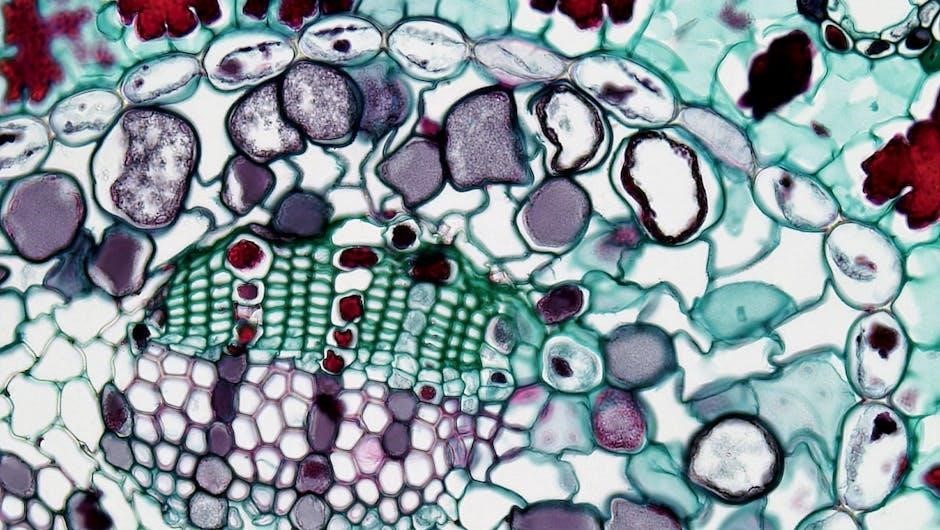Plant cell coloring introduces students to cell structure, using
- coloring activities
and diagrams to identify organelles, with answer keys providing correct colors and functions, available as pdf downloads for educational purposes, teaching cell biology concepts effectively through visual learning methods and interactive exercises online.
Overview of Plant Cell Structure
A plant cell is a complex structure consisting of various organelles, each with unique functions, and understanding these components is essential for plant cell coloring activities. The cell wall, a rigid layer outside the cell membrane, provides support and protection, while the cell membrane, a thin layer of lipid and protein molecules, regulates the movement of materials in and out of the cell. The cytoplasm, a jelly-like substance inside the cell membrane, contains various organelles, including the nucleus, mitochondria, endoplasmic reticulum, and ribosomes, which work together to maintain cellular functions. The nucleus, the control center of the cell, contains genetic material, and the mitochondria generate energy for the cell through cellular respiration. The endoplasmic reticulum, a network of membranous tubules, is involved in protein synthesis, transport, and storage, while the ribosomes, small organelles found throughout the cytoplasm, are responsible for protein synthesis. Other organelles, such as the golgi complex, vacuoles, and lysosomes, also play critical roles in plant cell function and structure. By understanding the functions and relationships of these organelles, students can accurately complete plant cell coloring activities, using pdf answer keys to guide their learning and assess their knowledge of plant cell structure.
Plant cell structure is typically represented in diagrams, which are used in coloring activities to help students identify and label the different organelles, and these diagrams often include labels and descriptions of the various cell components. The use of coloring activities and diagrams provides an interactive and engaging way for students to learn about plant cell structure and function, and the availability of pdf answer keys ensures that students can accurately assess their knowledge and understanding of plant cell biology.

Plant Cell Components

Plant cells contain
- organelles
like nuclei, mitochondria, and vacuoles, each with specific functions, and are typically represented in coloring activities with corresponding answer keys, providing a comprehensive understanding of cell biology through interactive learning methods and online resources available as pdf downloads.
Labeling and Coloring Activity
The labeling and coloring activity is a crucial part of learning about plant cell structure, as it allows students to visualize and identify the different organelles and their functions. This activity typically involves a diagram of a plant cell, which students must label and color according to the corresponding organelles. The activity is often accompanied by a word bank, which provides the correct terms for each organelle, and an answer key, which provides the correct colors and functions for each organelle.
By using online resources, such as pdf downloads, students can access a variety of labeling and coloring activities, each with its own unique twist and level of difficulty. Some activities may focus on specific organelles, such as the nucleus or mitochondria, while others may provide a comprehensive overview of the entire plant cell.
The labeling and coloring activity is an effective way to teach cell biology, as it allows students to interact with the material in a hands-on way, and to develop a deeper understanding of the structure and function of plant cells. Additionally, the activity can be adapted to fit different learning styles and levels, making it an accessible and engaging tool for students of all ages and abilities.
Overall, the labeling and coloring activity is a valuable resource for students learning about plant cell structure, and can be used in conjunction with other educational materials, such as textbooks and online tutorials, to provide a comprehensive and engaging learning experience. By using this activity, students can develop a strong foundation in cell biology, and gain a deeper understanding of the complex and fascinating world of plant cells.

Plant Cell Worksheet and Answer Key
The plant cell worksheet provides a diagram to label and color, with an answer key offering correct colors and functions, available as a pdf download for educational purposes, teaching cell biology concepts through interactive exercises and visual learning methods online effectively every day.
Plant Cell Quiz and Anatomy Activity
The plant cell quiz and anatomy activity is designed to test students’ understanding of plant cell structure and function, with a series of questions and labeling exercises that require students to identify and describe the different parts of a plant cell. The activity includes a diagram of a plant cell with various organelles labeled, and students are asked to label and color the different parts of the cell. The quiz also includes questions about the functions of the different organelles, such as the cell wall, mitochondria, and chloroplasts.

The plant cell anatomy activity is a great way for students to learn about the structure and function of plant cells, and to develop their critical thinking and problem-solving skills. The activity is available as a pdf download, and includes an answer key that provides the correct answers to the quiz questions and labeling exercises. This makes it easy for teachers to assess student understanding and provide feedback. The plant cell quiz and anatomy activity is a valuable resource for teachers and students alike, and can be used in a variety of educational settings, from middle school to college-level biology classes.
The activity is designed to be engaging and interactive, with a variety of questions and exercises that challenge students to think critically about plant cell structure and function. The quiz and anatomy activity can be completed individually or in groups, and can be used as a homework assignment or as a classroom activity. Overall, the plant cell quiz and anatomy activity is a great way for students to learn about plant cells and develop their critical thinking and problem-solving skills. The activity is easy to use and understand, and is a valuable resource for teachers and students. The plant cell quiz and anatomy activity is available online, and can be downloaded and printed for use in the classroom.

Be First to Comment